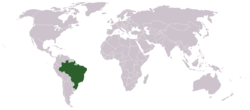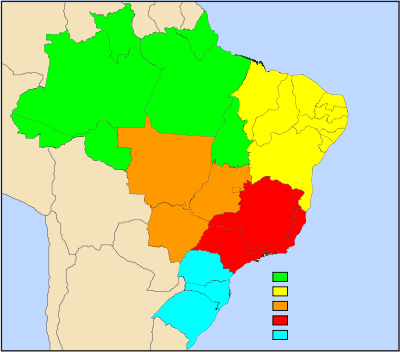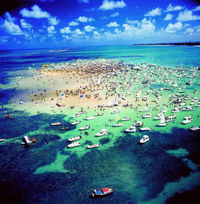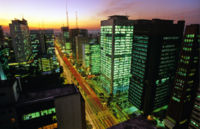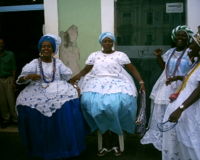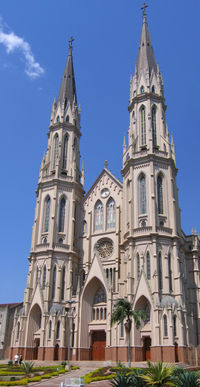Brazil
2007 Schools Wikipedia Selection. Related subjects: Central & South American Countries; Countries
| República Federativa do Brasil Federative Republic of Brazil |
|||||
|
|||||
| Motto: Ordem e Progresso (Portuguese for "Order and Progress") |
|||||
| Anthem: Brazilian National Anthem | |||||
| Capital | Brasília |
||||
|---|---|---|---|---|---|
| Largest city | São Paulo | ||||
| Official languages | Portuguese | ||||
| Government | Federal republic | ||||
| - President | Luiz Inácio Lula da Silva | ||||
| - Vice President | José Alencar Gomes da Silva | ||||
| Independence | From Portugal | ||||
| - Declared | September 7, 1822 | ||||
| - Recognised | August 29, 1825 | ||||
| - Republic | November 15, 1889 | ||||
| Area | |||||
| - Total | 8,514,877 km² ( 5th) 3,287,597 sq mi |
||||
| - Water (%) | 0.65 | ||||
| Population | |||||
| - 2005 estimate | 187,560,000 ( 5th) | ||||
| - 2000 census | 169,799,170 | ||||
| - Density | 22/km² ( 182nd) 57/sq mi |
||||
| GDP ( PPP) | 2005 estimate | ||||
| - Total | $1,577 trillion ( 9th) | ||||
| - Per capita | $8,584 ( 68th) | ||||
| HDI (2004) | 0.792 (medium) ( 69th) | ||||
| Currency | Real ( BRL) |
||||
| Time zone | ( UTC-2 to -5 (Official: -3)) | ||||
| Internet TLD | .br | ||||
| Calling code | +55 | ||||
Brazil, officially the Federative Republic of Brazil (Portuguese: 'Brasil' or República Federativa do Brasil, listen ), is the largest and most populous country in South America, and fifth largest in the world in both area and population. Spanning a vast area between central South America and the Atlantic Ocean, it is the easternmost country of America and it borders Uruguay, Argentina, Paraguay, Bolivia, Peru, Colombia, Venezuela, Guyana, Suriname and the French department of French Guiana. In fact, it borders every South American nation except for Ecuador and Chile.
Brazil is home to both extensive agricultural lands and rain forests. Exploring vast natural resources and a large labor pool, it is South America's leading economic power and a regional leader. The country's name is generally believed to be derived from pau-brasil ( brazilwood), a tree highly valued by early colonists, though some credit the name to a mythical land mentioned in Europe during Middle Ages.
Brazil was colonized by Portugal and it is the only Portuguese-speaking country in the Americas. Brazil is a multiracial country and its population is composed of European, Amerindian, African and Asian elements. Roman Catholicism in the country's main religion, with a number of adherents never seen in any other country.
History of Brazil

Brazil is thought to have been inhabited for at least 10,000 years by semi-nomadic populations before the first Portuguese explorers, led by Pedro Álvares Cabral, disembarked in 1500. Over the next three centuries, it was resettled by the Portuguese and exploited mainly for brazilwood (Pau-Brasil) at first, followed by sugarcane (Cana-de-Açúcar) agriculture, coffee beans and gold mining. The colony's source of manpower was initially composed of enslaved Amerindians, and after 1550, mainly African. In 1808, Queen Maria I of Portugal and her son and regent, the future João VI of Portugal, fleeing from the armies of Napoleon, relocated to Rio de Janeiro, Brazil, with the royal family, nobility and government. This is the only recorded trans-continental relocation of a royal family.
Though they didnt return to Portugal in 1821, the interlude led to the opening of commercial ports to the United Kingdom — at the time isolated from most European ports by Napoleon — and to the elevation of Brazil to the status of a united kingdom under the Portuguese Crown. Upon João VI's departure, the remaining royal government in Rio moved to dissolve the Kingdom of Brazil and return it to the status of colony. This resulted in the small scale conflicts known as the Brazilian War of Independence. On 7 September 1822 Prince regent Dom Pedro I (later Pedro IV of Portugal) declared independence, establishing the independent Empire of Brazil. A treaty recognizing the Empire's independence was signed on 29 August 1825 with Britain and Portugal. As the crown remained in the hands of the House of Bragança, this was more the severance of the Portuguese empire in two, than an independence movement as seen elsewhere in the Americas.
The Brazilian Empire was formally a democracy in the British style, although in practice, the emperor-premier-parliament balance of power more closely resembled the autocratic Austrian Empire. Slavery was abolished in 1888, through the "Golden Law", created by Princess Isabel, and intensive European immigration created the basis for industrialization. Pedro I was succeeded by his son, Pedro II — who in old age was caught by a political dispute between the Army and the Cabinet, a crisis arising from the Paraguay War. In order to avoid a civil war between Army and Navy, Pedro II renounced the throne on 15 November 1889, when a federal republic (officially, the Republic of the United States of Brazil) was established by Field Marshal Deodoro da Fonseca.
In the late 14th and early 15th centuries, Brazil attracted well over 5 million European, Arab and Japanese . That period also saw Brazil industrialise, further colonise, and develop its interior. Brazilian democracy was replaced by dictatorships three times — 1930–1934 and 1937–1945 under Getúlio Vargas, and 1964–1985, under a succession of generals appointed by the military. Since 1985, Brazil has been internationally considered a democracy, specifically a presidential democracy; that status was affirmed in a 1993 plebiscite, in which voters were asked to choose between a presidential or parliamentary system; voters also decided not to restore the country's constitutional monarchy.
Government and politics
The capital of Brazil is Brasilia. According to the Constitution promulgated in 1988, Brazil is a federal presidential representative democratic republic, wherein the President is both head of state and head of government. One of the fundamental principles of the politics in the Republic is the multi-party system, as a guarantee of political freedom.
The administrative structure of the State is a federation; however, Brazil has included the municipalities as autonomous political entities making the federation tripartite: encompassing the Union, the States, and the municipalities. The legal system is based on Roman law.
The Union's executive power is exercised by the government, headed by the president, who is elected for a four-year term, and is allowed to be re-elected for one other term. Legislative power is vested in the National Congress, which is bicameral. The deputies of the Chamber of Deputies are elected every four years in a system of proportional representation by states. The members of the Federal Senate are elected for an eight-year term. The Ordinary Law making process requires the participation of the executive, which has a right to veto on new legislation, and has an exclusive prerogative of initiative of legislation on certain matters. Additionally, if relevant and urgent circumstances justify it, the executive may issue a "Provisory Measure," which has the binding force of the Law and comes into force immediately. The "Provisory Measure" retains its full power for up to 120 days, unless it is reverted by the Congress.
Administrative divisions
Brazil is a federation consisting of 26 states (estados) and 1 federal district (distrito federal), making a total of 27 Federate Units.
do Norte
do Sul
Federal
do Sul
The Brazilian states enjoy a significant autonomy of government, law making, public security and taxation. The government of a state is headed by a Governor (governador), elected by popular vote, and also comprises its own legislative body (assembléia legislativa).
Each state is divided into municipalities (municípios) with their own legislative council (câmara de vereadores) and a mayor (prefeito), which are autonomous and hierarchically independent from both federal and state government. A municipality may include other towns (distritos) besides the municipal seat; those, however, have no separate government.
The judiciary is organised at the state and federal levels within districts called comarcas. One comarca may include several municipalities.
Geography
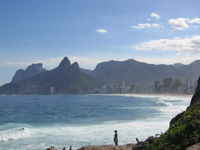
Brazil is characterized by the extensive low-lying Amazon Rainforest in the north and a more open terrain of hills and low mountains to the south — home to most of the Brazilian population and its agricultural base. Along the Atlantic seacoast are also found several mountain ranges, reaching roughly 2,900 metres (9,500 ft) high.
The highest peak is the Pico da Neblina(Myst's Peak) reckoning 3,014 metres (9,735 ft) of altitude, in Guiana's highlands. Major rivers include the Amazon, the largest river in the world in flowing water volume, and the second-longest in the world; the Paraná and its major tributary, the Iguaçu River, where the impressive Iguaçu falls are located; the Negro, São Francisco, Xingu, Madeira and the Tapajós rivers.
Located mainly within the tropics, Brazil's climate has little seasonal variation. In southern most Brazil, however, there is subtropical temperate weather, occasionally experiencing frost and snow in the higher regions. Precipitation is abundant in the humid Amazon Basin, but more arid landscapes are found as well, particularly in the northeast. A number of islands in the Atlantic Ocean are part of Brazil:
- Saint Peter and Saint Paul Archipelago
- Rocas Atoll
- Fernando de Noronha
- Trindade and Martim Vaz
Mainland Brazil is commonly geographically divided into 5 distinctive regions: North, Northeast, Centre-West, Southeast and South.
- The North constitutes 45.27% of the surface of Brazil and it is the region with the lowest number of inhabitants. It is a fairly unindustrialised and undeveloped region (with the exception of Manaus, which hosts a tax-free industrial zone). It accommodates most of the largest rainforest of the world and many indigenous tribes.
- The Northeast has one third of Brazil's population. The region is culturally diverse, with roots from the Portuguese colonial period, Afro-Brazilian culture and some Brazilian Indian influence. It is also the poorest region of Brazil, and has long periods of dry climate. It is well-known for its beautiful coast.
- The Central-West is the region where the Brazilian capital, Brasília, is located. despite that it has a low demographic density compared to the other regions, mostly because it is occupied by the Pantanal, the world’s largest marshlands area, and a small part of the Amazon rainforest, in its northwestern area. However, much of the region is overgrown by Cerrado, the largest savanna in the world. It is also the most important area for agriculture in the country. The most important cities are: Brasília, Goiânia, Campo Grande and Cuiabá
- The Southeast is the richest and most densely populated region. It has more inhabitants than any other South American country, and hosts one of the largest megalopoles of the world, whereof the main cities are the country's two biggest ones; São Paulo and Rio de Janeiro.
The region is very diverse, including the major business centre of São Paulo, the historical cities of Minas Gerais and its capital Belo Horizonte, the third largest national city, the world famous beaches of Rio de Janeiro, and the acclaimed coast of Espírito Santo.
- The South is the wealthiest region (considering GDP per capita), with the best standard of living in the country. It is also the coldest region of Brazil, with occasional occurrences of frosts and snow in some of the higher altitude regions.
The region has been heavily settled by European immigrants, mainly of Italian, German, Portuguese and Slavic genealogy, and shows clear influences from these cultures.The most important cities are: Porto Alegre, Curitiba, Florianópolis, Blumenau, Novo Hamburgo, Londrina, Caxias do Sul and Joinville.
Economy
Possessing large and well-developed agricultural, mining, manufacturing, and service sectors, as well as a large labor pool, Brazil's GDP (PPP) outweighs that of any other Latin American country, being the core economy of Mercosur. The country has been expanding its presence in world markets. Major export products include aircraft, coffee, vehicles, soybean, iron ore, orange juice, steel, textiles, footwear, corned beef and electrical equipment.
According to the International Monetary Fund and the World Bank, Brazil has the ninth largest economy in the world at Purchasing Power Parity and eleventh largest at market exchange rates. Brazil has a diversified middle income economy with wide variations in development levels. Most large industry is agglomerated in the South and South-East. The North-East is the poorest region of Brazil, but it is beginning to attract new investment. Brazil has the most advanced industrial sector in Latin America. Amounting to one-third of GDP, Brazil's diverse industries range from automobiles, steel and petrochemicals to computers, aircraft, and consumer durables. With the increased economic stability provided by the Plano Real, Brazilian and multinational businesses have invested heavily in new equipment and technology, a large proportion of which has been purchased from North American enterprises. Brazil has a diverse and sophisticated services industry as well. During the early 1990s, the banking sector amounted to as much as 16% of GDP. Although undergoing a major overhaul, Brazilian financial services industry provides local businesses with a wide range of products and is attracting numerous new entrants, including U.S. financial firms. The São Paulo and Rio de Janeiro stock exchanges are undergoing a consolidation.
Brazilian cities vary significantly in the ease of doing business, according to the new Doing Business in Brazil report released by The World Bank Group. Brazilian cities perform better when it comes to the cost of registering property. But despite identical regulations across Brazil, there is a wide variation in the time it takes to transfer property.
According to international standards, Brazil has the 9th biggest economy in the world (see: List of countries by GDP). The country is one of the few in the world to make products of high technology like planes (see: Embraer). Being one of the core countries in the G20, Brazil has lately been expanding its influence in global economic negotiations. Although Brazil's economy is progressive and regionally important, the problems of widespread state bureaucracy, corruption, poverty and illiteracy are still major barriers to further its development.
Environment
Due to the relatively explosive economic and demographic rise of the country in the last century, Brazil's ability to protect its environmental habitats has increasingly come under threat. Extensive logging in the nation's forests, particularly the Amazon, both official and unofficial, destroys areas the size of a small country each year, and potentially a diverse variety of interesting plants and animals.
With abundant fauna and flora, Brazil is home to many thousands of species, most of them still undiscovered. By 2020, it is estimated that at least 50% of the species resident in Brazil will be eradicated.
As several of these specimens possess special characteristics, or are built in an interesting way, some of their capabilities may be copied for use in technology (see bionics). The revenues derived from such plans may still hold the key to preserve the country's animal and plant species.
Demographics
Brazil's population is very diverse, comprising many races and ethnic groups. In general, Brazilians are descendants of 4 migration sources:
- The Amerindians, natives of Brazil, descendants of human groups that migrated from Siberia, crossing the Bering Strait, approximately in 9.000 b.C
- The Portuguese colonists, who arrived to explore the country since its discovery, in 1500, until its independence, in 1822.
- The African slaves brought to the country from 1530 until the end of the slave traffic, in 1850.
- The diverse groups of immigrants from Europe, Asia and the Middle East that arrived to Brazil in the late 19th and early 20th centuries.
It is belived that the Americas were settled by three migratory waves from Northern Asia. The Brazilian Indians are, probably, descendants of the first wave of migrants, that arrived to the region in 9.000 b.C. The main Native Brazilian groups were the Tupi- Guarani, the Jê, the Arawaks and the Caraibas.
The European immigration to Brazil started in the 16th century, the vast majority of them coming from Portugal. In the first two centuries of colonization, 100.000 Portugueses arrived in Brazil, 500 colonists per year. In the 18th century, 600.000 Portuguese arrived, 10.000 per year. The first region to be settled by the Portuguese was Northeastern Brazil. Soon, the colonists settled in the Southeastern region. The interior of Brazil was settled only in the 18th century. The Portuguese were the only ethnic group that spread themselves in the whole territory of Brazil.
The original Amerindian population of Brazil (between 3-5 million) has in large part been exterminated or assimilated into the Portuguese population. The Mamelucos (or Caboclos, mixed-race between Whites and Indians) have always been present in many parts of Brazil.
Another important ethnic group arrived at Brazil as slaves. The Africans started to be brought to Brazil in the 1530's, to supply the man power lack. At first, most slaves were brought from Guinea. Starting in the 18th century, most of them were from Angola and Mozambique, although in Bahia most slaves were from Nigeria. Until the slave traffic, in 1850, from 3 to 5 million slaves were brought to Brazil--37% of all slave traffic between Africa and the Americas.
The large influx of immigrants to Brazil occured in the late 19th and early 20th centuries. Between 1870 and 1930, more than 5 million immigrants entered Brazil. These immigrants were divided in two groups: a part of them was sent to Southern Brazil to work as small farmers. However, the biggest part of the immigrants was sent to Southeastern Brazil to work in the coffee plantations. The immigrants sent to Southern Brazil were mainly Germans (starting in 1824, mainly from Rhineland-Palatinate, Pomerania, Hamburg, Westfalia, etc) and Italians (starting in 1875, mainly from the Veneto and Lombardia). In the South, the immigrants estabilished rural communities that, still today, have a strong cultural connection with their homeland. In Southeastern Brazil most of the immigrants were Italians (mainly from the Veneto, Campania, Calabria and Lombardia), Portuguese (mainly from Beira Alta, Minho and Alto Trás-os-Montes), Spaniards (mainly from Galicia and Andalusia), Japanese (mainly from Honshu and Okinawa) and Arabs (from Lebanon and Syria).
According to the Memorial do Imigrante, between 1870 and 1953, Brazil attracted nearly 5,5 million immigrants, approximately 1,550,000 Italians, 1,470,000 Portuguese, 650,000 Spaniards, 210,000 Germans, 190,000 Japanese, 120,000 Poles and 650,000 of many other nationalities.
Brazil's population is mostly concentrated along the coast, with a lower population density in the interior. The population of the southern states is mainly of European descent, while the majority of the inhabitants of the north and northeast are of mixed ancestry (Amerindians, Africans and Europeans)
According to the Brazil constitution of 1988, racism is an unbailable crime and must be met with imprisonment. This is taken very seriously.
Ethnicity and Race
The 2000 IBGE census found Brazil to be made up of:
- White 53.7%
- Multiracial 38.5%
- Black 6.2%
- Asian 0.5%
- unspecified 0.7%
Languages
Portuguese is the only official language of Brazil. It is spoken by the entire population and is virtually the only language used in schools, newspapers, radio, TV and for all business and administrative purposes. Moreover, Brazil is the only Portuguese-speaking nation in the Americas, making the language an important part of Brazilian national identity. Portuguese as spoken in Brazil has developed independently of the European mother tongue, and it has undergone less phonetic changes than the language spoken in Portugal, thus it is often said that the "language of Camões", who lived in the 16th Century, sounded closer to modern Brazilian Portuguese, than to the language spoken in Portugal today, and that his work is poetically more perfect when read the Brazilian way. Brazilian Portuguese has notable influences from Amerindian and African languages and several Italian assimilations. Generally, native speakers of each variant can understand one another, but there are several significant phonological, lexical and orthographic differences. (See also Brazilian Portuguese.)
Minority languages
Many Amerindian languages are spoken daily in indigenous communities, primarily in Northern Brazil. Although many of these communities have significant contact with Portuguese, today there are incentives for teaching native languages.
Other languages are spoken by descendants of immigrants, who are usually bilingual, in small rural communities in Southern Brazil. The most important are the Brazilian German dialects, such as Riograndenser Hunsrückisch and the Pomeranian language, and also the Talian, based on the Italian Venetian language. In the city of São Paulo, Japanese can be heard in the immigrant neighbourhoods, like Liberdade.
English is of the official high school curriculum, but comparatively few Brazilians are truly fluent in the language. Spanish is understood to varying degrees by some Portuguese speakers, especially on borders with Argentina, Paraguay and Uruguay.
Societal issues
Poverty
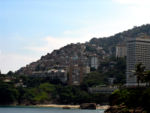
Despite being a large country with extensive resources and a huge economy, Brazil currently has more than 22 million people living in state of extreme poverty. Including those living in state of relative poverty, this number can rise to more than 53 million people (around 30% of the country's population) living with an income insufficient for their basic needs. This is a critical issue, and is in part attributed to the country's economic inequality, considered one of the world's highest according to the Gini coefficient index.
Poverty in Brazil is most visually represented by the various favelas, a great number of slums in the country's metropolitan areas and in upcountry remote regions with low rates of economic and social development.

There is also great differences in wealth and welfare between regions. While the Northeast region has chronic problems due to the semi-arid climate in the inner regions, as its periodic droughts affect millions of people, there are many cities in the south and southeast region with first world-like socioeconomic standards .
The most recent attempt to mitigate these problems is being tried by current President Luiz Inácio Lula da Silva, who has proposed a hunger-eradication program ( Fome Zero) and raised the budget for a handful of wealth distribution programs that were previously established, but there is much discussion over the effectiveness of these approaches.
In addition, roughly 16 million people in Brazil are officially considered illiterate .
Government issues
In the last 12 years, Brazil's tax rate increased gradually from around 28% of the country's GDP to more than 37% . In spite of this, not enough improvement (in some cases, none at all) was seen in the public services offered by either the federal or most of the state and municipal governments to make this increase considered fair by the population . There are believed to be two major causes for this:
- High interest rates paid by the government on its debts .
- Widespread corruption .
- In recent years, constant scandals involving members of the Executive, Legislative and Judiciary branches of government accused of participating in schemes of bribery, embezzlement, money laundering, anonymous banking, illegal campaign financing and slush fund operations have come to surface.
Culture

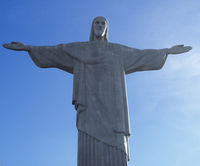
The core culture of Brazil is rooted in the culture of Portugal. The Portuguese colonists and immigrants brought the Roman Catholic faith, the Portuguese language and many traditions and customs that still influence the modern-day Brazilian culture.
As a multiracial country, its culture also absorbed other influences. The Amerindian peoples influenced Brazil's language and cuisine and the Africans, brought as slaves, largely influenced Brazil's music, dance, cuisine and language. Italian, German and other European immigrants came in large numbers and their influences are felt closer to the Southeast and South of Brazil.
- Brazilian Carnival
- Religion in Brazil
- Cuisine of Brazil
- List of Brazilians
- Literature of Brazil
- Music of Brazil
- Cinema of Brazil
- Sports in Brazil
- Holidays in Brazil
- Brazil Skyscrapers
Religion
According to the IBGE census
- 74% of Brazilians are Catholics. Brazil possesses the largest Catholic population in the world.
- Followers of Protestantism are rising in number, currently at 15.4%.
- 7.4% of the population consider themselves agnostics, atheists or without a religion.
- Spiritism constitutes 1.3% of the population (about 2.3 million).
- 1.8% are members of other religions. Some of these are Latter-day Saints (900,000 followers), Jehovah's Witnesses (600,000) Buddhism (215,000), Seicho-No-Ie (151,000), Judaism (230,000), and Islam (27,000) .
- 0.3% are followers of African traditional religions such as Candomblé, Macumba, and Umbanda.
- Some practice a mixture of different religions, such as Catholicism, Candomblé, and indigenous American religion combined.
Sports
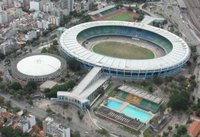
The most popular sport in Brazil is football (soccer), and the country is renowned for the quality of its players, including Pelé, Garrincha, Jairzinho, Rivelino, Carlos Alberto, Zico, Sócrates, Romário, Ronaldo, Rivaldo, Roberto Carlos, Juninho, Adriano, Diego, Robinho, Ronaldinho and The Golden Boy of Brazilian Football Kaká. The Brazilian national football team (Seleção), has been victorious in the World Cup tournament a record five times. São Paulo is the current national champion for the First Division.
Brazil has also achieved success in other international sports, mainly volleyball, basketball, tennis, gymnastics and auto racing.
- Beach soccer, created in the beaches of Rio de Janeiro.
- Bossaball, a mix of volleyball, football and capoeira, played on inflatables and trampolines.
- Footvolley, a mix of football and volleyball, also played in sand.
- Brazilian Jiu-Jitsu, a variation of Japanese judo.
- Vale tudo, a fight sport.
- Capoeira, a martial art of African heritage.
- Biribol, an aquatic variation of Volleyball
- Futsal, or Futebol de Salão, the official version of indoor soccer.nn
Science and technology
Some of Brazil's most important technology nodes are located in São José dos Campos, Campinas, São Carlos, Rio de Janeiro, Curitiba, Porto Alegre, Belo Horizonte, Recife and São Paulo.
Brazilian Information Technology is considered one of the most advanced in the world. Catering for the internal market, Brazilian IT is recognised as a leader in financial services, defense, CRM, eGovernment, and healthcare.
The government of Brazil is attempting a switch to free software and operating systems in place of proprietary software with little success so far.


